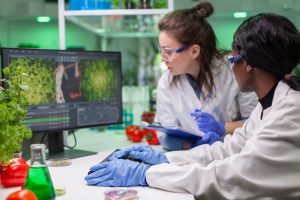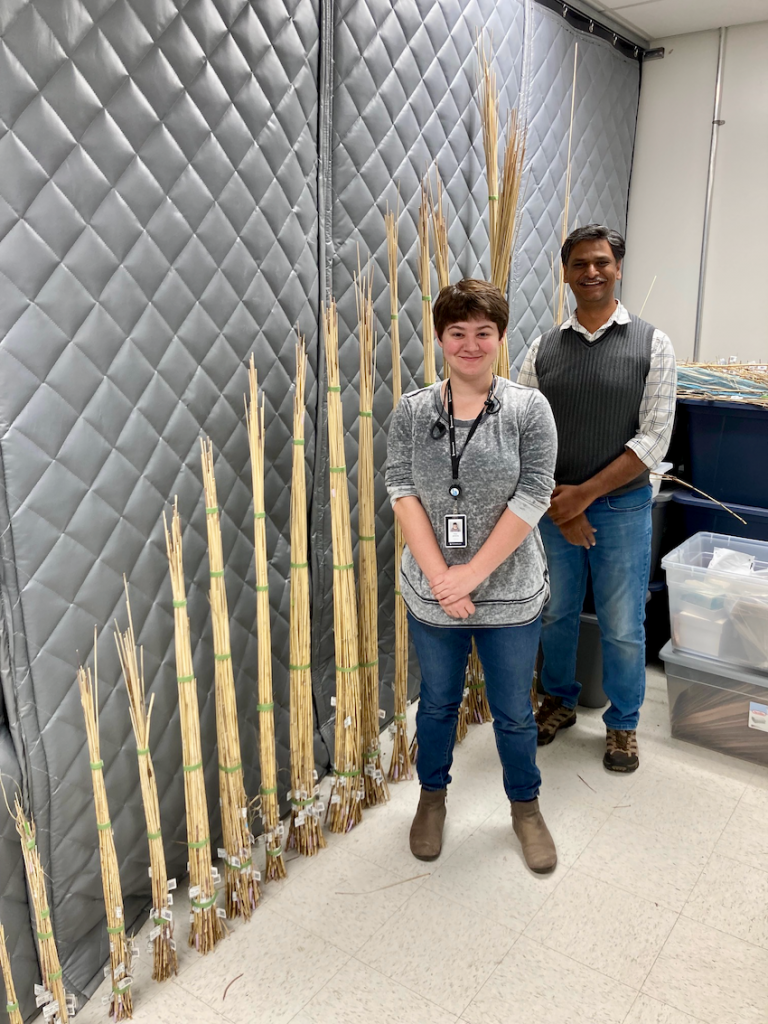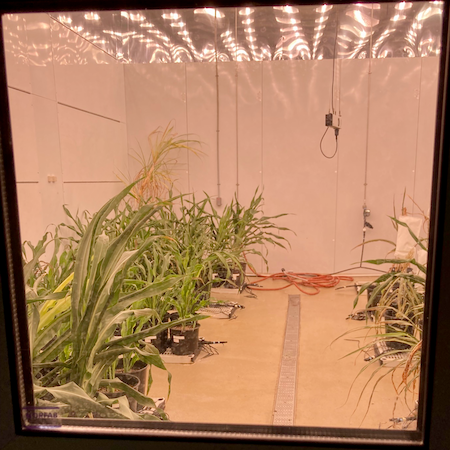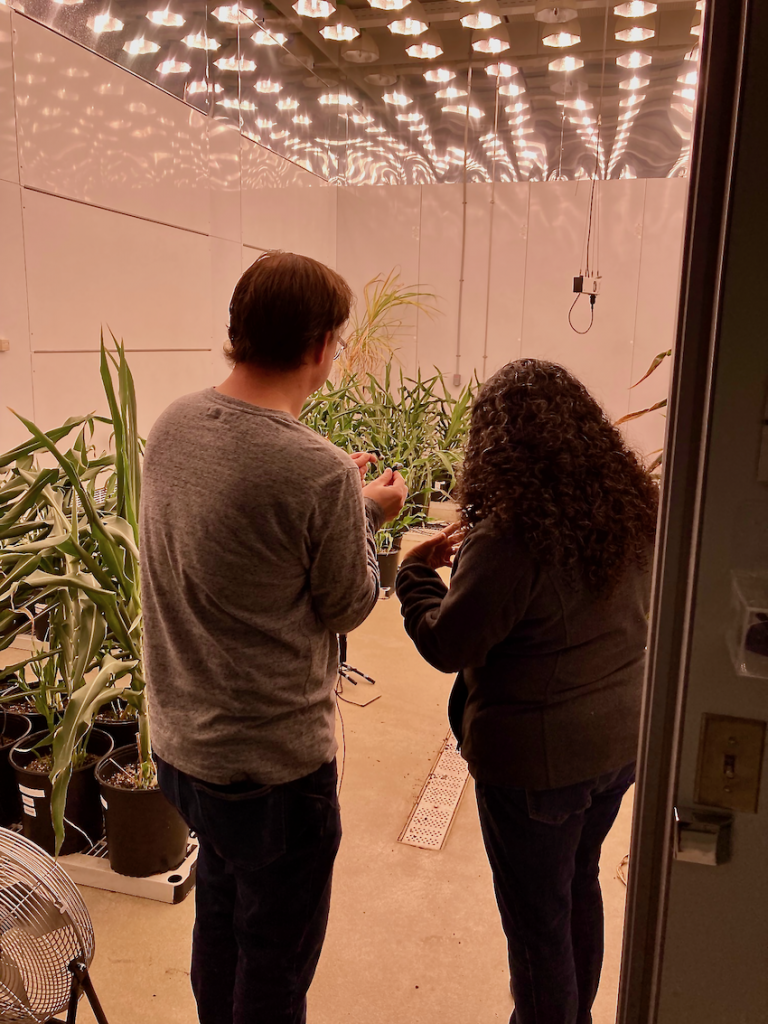
 In the final episode of Season 2, we are journeying into the world of agricultural biotechnology to learn how scientists are helping to feed and fuel the world. But first, what is biotechnology?
In the final episode of Season 2, we are journeying into the world of agricultural biotechnology to learn how scientists are helping to feed and fuel the world. But first, what is biotechnology?
For many, hearing the word ‘biotechnology’ immediately brings forth images of vaccines, pharmaceutical drugs, and genetic engineering technology. While these are definitely important feats of biotechnology, it actually encompasses so much more than that.
Simply put, biotechnology makes use of biological systems and organisms to develop technologies and products that help improve our lives and the health of our planet. Biotechnology plays a key role in protecting our planet’s resources, driving a strong economy, and enhancing people’s lives. It is predicted that by the year 2050 the world’s population will be 9.7 billion people, nearly 2 billion more than we currently have on our planet.
 These people will depend on biotechnological innovation to create viable ways to produce the food we grow, the materials we use, and the fuel that helps transport us. Biotechnology gives us solutions derived from nature that drive food and farm innovation, biobased manufacturing, and the utilization of cleaner energy.
These people will depend on biotechnological innovation to create viable ways to produce the food we grow, the materials we use, and the fuel that helps transport us. Biotechnology gives us solutions derived from nature that drive food and farm innovation, biobased manufacturing, and the utilization of cleaner energy.
Listen to Tiny Expeditions Season 2, Episode 6: “How is biotechnology helping to feed and fuel the world?” to learn some of the roles that biotechnology plays in the plant and agricultural fields, and how scientists are using science and technology to help feed and fuel earth’s growing population.
Behind the Scenes


Kankshita Swaminathan, PhD (pictured left), is passionate about using the genomic technologies available to her to help build a more sustainable future. A lot of the work that she and her lab currently pursue is focused on creating more productive and efficient plants for use in bioenergy.
Our trip to the Swaminathan dirt lab and growth rooms allowed us to see two of these plants in person—the grasses Miscanthus and sorghum. The first stop of our tour was the dirt lab. The researchers call it this because it is the space where plants from the field are brought for analysis. As you can imagine, a lot of these plants are dirty, hence the name dirt lab.
In the dirt lab, we met two of Dr. Swaminathan’s lab members. Pradeep Hirannaiah, PhD is a postdoctoral fellow in the lab. Wren Jenkins is an undergraduate student intern in the lab. Wren and Pradeep were phenotyping many stalks of dried grass to see which plants possessed desirable traits for use as bioenergy feedstock (pictured in the bottom left image).
After we left the dirt lab we walked down the hall to the growth rooms. These rooms allow researchers to grow plants indoors under conditions that mimic being in the field. Precision controls allow the researchers to control the lights, humidity, and temperature to create specific environments based on their experimental needs. As you heard on the episode, the growth room we entered was loud, bright, and very humid (images on the right). The sorghum seemed to like it because it was thriving and growing beautifully.


Chris Powell 00:06
Welcome to the season finale of Season Two of Tiny Expeditions.
Sarah Sharman 00:10
Today we will journey into the world of agricultural biotechnology and learn how science is helping to feed and fuel the world.
Chris Powell 00:18
My name is Chris and today I’m gonna be your storytelling guide.
Sarah Sharman 00:21
And I’m Dr. Sarah Sharman, your science advisor for this journey.
Chris Powell 00:24
Throughout the season you have heard from many of HudsonAlpha’s agricultural researchers.
Sarah Sharman 00:29
Today you’ll hear from a brand-new voice on the podcast, HudsonAlpha Faculty Investigator Dr. Kankshita Swaminathan.
Kankshita Swaminathan 00:39
I’m Kankshita Swaminathan. I’m a faculty investigator at HudsonAlpha. And my interests are to understand what genes do and how they contribute to phenotypes or traits of interest.
Chris Powell 00:58
The life sciences field is a very large field. The field of agricultural genomics is much smaller, and much more specific. So, we asked Dr. Swaminathan, how is it that you got interested in this very specific field.
Kankshita Swaminathan 01:12
Before I came to HudsonAlpha, most of my work was primarily in genomics and transcriptomics. And the field of genomics in plants has moved leaps and bounds. And at this point, we have absolutely beautiful genomes, which is we’ve strung together and assembled. And Jeremy Schmutz’s group, for example, is an expert at putting these genomes together. And once you have the genomes, which is basically just the DNA piece, you then use computational methods to figure out what all the genes are. But a lot of the genes we actually don’t quite understand, we have no idea of what they do and how they’re influencing or the important function that they play in the plant life. And so, to me, to some extent, it was a frustration and an opportunity, at the same time where we had these beautiful genomes, we were excited about all these genes going up and down. If you, for example, gave a plant nitrogen or starved of nitrogen. But we didn’t really know what each of these things that go up and down do. And so, I was looking for a way to go downstream of that effort to kind of try and understand gene function to understand plant biology. And then, hopefully, at the next step, you can influence plant breeding. So, I think, as we try to build a more sustainable future, we need to actually understand the biology of plants so that we can actually build that sustainable future. And so that’s where my interest came.
Sarah Sharman 03:12
Today we’re talking with Dr. Swaminathan about some very specific applications of biotechnology and agricultural research. But first, let’s make sure we’re all on the same page about what biotechnology actually is. Chris, when you think about biotechnology, what comes to mind?
Chris Powell 03:28
As a non-scientist, I think my image of biotechnology is more informed by science fiction and popular reading or maybe even the Jetsons, you know, like images of spare body parts and organs being grown in a field or corn growing in rows on the surface of the moon. I’m assuming from the look on your face that those are probably not realistic applications, though.
Sarah Sharman 03:51
Well, I don’t know if I was the only one here for the space episode but corn on the moon might be possible soon. Extra body parts on plants. I’m not so sure. Why don’t we turn this over to Dr. Swaminathan and hear what she thinks the definition of biotechnology is.
Kankshita Swaminathan 04:06
Plant biotechnology is a set of tools at our disposal, using which we can influence plant traits. For example, you can use Agrobacterium-mediated transformation of plant cells to add gene function or add in CRISPR/cas9 to edit a plant. You can also use a particle gun, which is tiny little gold particles, which you coat with DNA and you bombard plant cells to get that DNA inside the plant. And then those plants will now you can select for things which have the DNA of interest. So, these are all tools which are used in plant biotechnology, these can get more sophisticated. If you are into plant engineering where you actually want to engineer a whole pathway, you can use these tools to help you engineer a whole pathway. And ultimately, adapt or manipulate plants to manifest a trait of interest. So, we use all the tools available to try and understand how genes influence phenotypes are traits of interest.
Kankshita Swaminathan 05:38
And I’m going to, for an example, talk about a plant that has many branches versus a plant that doesn’t have very many branches. And you’re trying to understand what genes actually contribute to the branching. You can then create a cross between the two different types and then look at the progeny and then the progeny of those progeny. And these are called, you know, the F1 is the first generation, and the F2 is the second generation. By the time you get to the F2, you have scrambled up those genomes a little bit. And so, the trait which is the branching is going to vary in the different progeny that you’re looking at. And so, you can score this. And once you’ve got scores for it, if you’ve got genomic information, which tells you all the genetic variation between each of these lines, you can then correlate the two things and figure out which parts of the genome actually are tied with that trait of interest, which is branching in this case.
Chris Powell 06:45
The example that Dr. Swaminathan just gave us is a theoretical example. Later in the day, though, we were able to visit her lab and growth rooms to see real-world applications of this process. So come along with us. Let’s go into the lab and the growth rooms.
Kankshita Swaminathan 07:01
This is Wren. She is an undergraduate intern in the lab. And this is Pradeep who is a postdoc in the lab. So, what Wren and Pradeep are working on is a genetics experiment where they are looking at phenotypes of interest in a cross between two Miscanthus species.
Sarah Sharman 07:24
Miscanthus is a type of grass that you might have seen in ornamental landscaping, certain varieties of it can grow actually taller than a human. Dr. Swaminathan’s group is studying Miscanthus for its potential as bioenergy.
Chris Powell 07:37
What are we looking at here?
Wren Jenkins 07:38
These are Miscanthus stalks that are from two different sample areas. Some of them are from Mississippi State University. And some of them are from the field at Alabama A&M. Some of these are from this year, and some of them are from last year. But the ones that we’re looking at this year are crosses between two different species of this campus that have different traits. And so, in the crossbreed, we’re examining the traits of the offspring to see which parent they represent. And then that will be compared with sequencing data to see how things are stacking up and why they’re happening that way. So, we’re looking at height, we’re looking at diameter, we’re looking at the branching trait, which is only seen one of the parent species, and we’re also examining traits of the flowers.
Sarah Sharman 08:30
As you just heard Wren is an intern from a local university. You may have picked up from our previous episodes that teaching the next generation of scientists is extremely important to our faculty and researchers. Wren actually started working in the lab as a high school student, and she’s now preparing for graduate school.
Sarah Sharman 08:54
Not every experiment starts in the field with plants. Some of them start with a gene of interest and work back to figure out the function.
Kankshita Swaminathan 09:02
We have an experiment in the lab right now, which is we’ve grown sorghum in different levels of nitrogen. And we’ve looked at the genes that go up and down depending on how much nitrogen the plant is perceiving. Nitrogen is something that is important for all plants. And in general, even the plants that don’t need a whole lot of nitrogen to thrive, if you give it nitrogen, you will see a boost in biomass, and you will see a boost in yield.
Sarah Sharman 09:37
To determine whether the identified genes actually play an important role in the nitrogen response of the plant. The researchers use another biotechnology tool.
Kankshita Swaminathan 09:47
So, what we do is overexpress a gene, for example, which is to put the coding region or the protein coding region of the gene under a strong promoter so that its gene function is always on. And in parallel, we also try and knock out the gene function. And we use tools like gene editing to do that. And so, the idea is if you create mutations in the gene, you are going to disrupt the protein and disrupt gene function in combination, right when you overexpress it. If you’ve knocked it down, you can now grow these plants under different nitrogen levels, and then look again at the phenotypic variation, and how the plant is responding to the availability of nitrogen. And by doing this repeatedly for multiple genes, you can actually begin to understand the influence of these genes on nitrogen response on the nitrogen response of the plant.
Chris Powell 10:58
We just heard how Dr. Swaminathan’s lab is looking at genes involved in nitrogen response and sorghum. Let’s take a step back and hear about what sorghum is and why it’s an important plant to study.
Kankshita Swaminathan 11:10
Sorghum is a grass that is very closely related to corn and is also closely related to sugarcane. Both of which are well-known crops, one for sugar and one for corn for its starch and feed purposes. Sorghum used to be grown a lot more here, and it is still a crop grown in other parts of the world. It’s used extensively as feed for animals in many places, and it can be used as a bioenergy plant. And so that versatility makes it an extremely interesting plant. And in all these cases, its yield is relatively high. We talked about genes and plant breeding and plant biotechnology before. And it’s pretty cool that you can actually have the same plant fit all these different industries.
Chris Powell 12:24
We’re gonna go into the growth rooms to see what sorghum looks like. And we’ll be your eyes and ears. In the meantime, though, just imagine a slightly shorter stalk of corn.
Chris Powell 12:35
Okay, so this is the growth chamber, correct?
Kankshita Swaminathan 12:38
Yes. Here are the airflow and sprayers, and it’s pretty noisy in these chambers.
Chris Powell 12:57
So, what are we looking at?
Kankshita Swaminathan 13:01
These are sorghum plants.
Kankshita Swaminathan 13:04
So, some of them are transgenic sorghum. Some of them are the wild-type parent of that transgenic sorghum. And so, we plant them routinely. We also plant wild-type to get seeds and embryos because that’s what we transform for, and that’s what we do all our editing.
Chris Powell 13:32
Wow, it’s hot.
Kankshita Swaminathan 13:38
It is, it’s hot. It’s always summer in the growth room.
Chris Powell 13:44
Always summer. So, does the plant think that it’s daylight all the time? Or is it set on a cycle?
Kankshita Swaminathan 13:52
It set on a cycle, it set on a day night cycle. And so that day night cycle can vary. For most part, because we grow a lot of different things in here, it’s about a 14-hour light cycle.
Chris Powell 14:10
So, from an untrained eye, it’s very easy to see the corn connection or what appears to be a corn connection.
Kankshita Swaminathan 14:19
It’s very easy to see that. So, I think if you didn’t know sorghum existed, I suspect that if you walk into this room, you think it’s corn.
Sarah Sharman 14:30
Let’s play a little game of word association, Chris.
Chris Powell 14:33
Excellent. Love these. Let’s do it.
Sarah Sharman 14:35
When I say corn, what do you think of?
Chris Powell 14:36
Corn? Easy popcorn, and more specifically cheddar popcorn.
Sarah Sharman 14:42
So, if sorghum is like corn, that begs the question of, can you pop sorghum like you popcorn?
Chris Powell 14:49
That would be a great use of biotechnology if you could do that especially if you can give me cheddar pop sorghum. I’m in.
Pradeep Hirannaiah 14:56
Sorghum mostly that you’ll see here, they’re sweet sorghum. And Africa and India use the grain sorghum and the one which is used for human consumption. And like the corn, like the popcorn, we do pop the sorghum and make the tiny little white circles.
Chris Powell 15:19
So how is it in relationship to popcorn? Is it sweeter? Or is it about the same? Or what’s the difference in it?
Pradeep Hirannaiah 15:27
Once they’re popped? I feel similar, like, similar. Yeah, similar. Maybe corn is tastier because it is bred for that. But it’s a little bit tastier. But yes, it is almost similar.
Chris Powell 15:48
I’m concerned that you may not be helping out any budding entrepreneurs that want to start selling pop sorghum here.
Kankshita Swaminathan 15:57
I think the key thing that he said, though, is that you have corn that had been bred for popcorn. Whereas the sorghum that he’s talking about that they popped was just grain sorghum probably bred for whatever reason that they put in a skillet or a wok and popped it.
Wren Jenkins 16:17
There’s nothing stopping you from breeding pop sorghum.
Kankshita Swaminathan 16:18
There’s nothing stopping you from breeeding pop sorghum, you could try.
Chris Powell 16:24
For me, honestly, the only context I’ve ever had from sorghum, I guess growing up in the South, is the syrup. You know, that’s the only thing I’ve ever known it for. Go into the pumpkin patch or whatever you pick up a jar of sorghum syrup. You know?
Kankshita Swaminathan 16:42
I think sorghum rum, too, from the syrup.
Chris Powell 16:45
Oh, really? Yeah. So, where do we find this? That sounds interesting.
Pradeep Hirannaiah 16:49
Like, I think Korea, Japan, and China have sorghum drink
Wren Jenkins 16:57
Soju is Korean. It has sorghum?
Pradeep Hirannaiah 17:03
It has rice and sorghum.
Kankshita Swaminathan 17:07
There is sorghum alcohol in China, for sure. But I don’t know which one it is. But here in the US, they used it for rum. I’m pretty sure, but you have to go do your homework on this.
Chris Powell 17:20
We were just given homework.
Chris Powell 17:23
Like good students, we did our homework that Dr. Swaminathan assigned to us. And we found out that she’s right. There is indeed a whole market in the US for sorghum rum. And not only that, but sorghum whiskey. If biotechnology can give us pop sorghum and sorghum rum, I think biotechnology is leading us in a pretty good direction.
Sarah Sharman 17:46
These are just a few of the examples of how biotechnology is helping to feed and fuel our world. As our population continues to grow and the climate changes, people will depend on biotechnology to create viable ways to produce the food we grow, the materials we use, and the fuel that helps transport us.
Chris Powell 18:04
Thank you for joining us for this season of Tiny Expeditions. We hope that you learned a lot about how genomics and biotechnology are benefiting the plant and agricultural sciences. We’ve been to college, trekked through a peanut field, and dreamed about going to space.
Sarah Sharman 18:20
Through all of our journeys, we gained a deeper appreciation for the work that is going on in labs across the world and even in space labs that are dedicated to improving and protecting our planet’s lives and livelihoods. From creating more sustainable crops to making sure our chocolate and beer stashes stay well stocked. Science has got us covered.
Chris Powell 18:41
Tiny Expeditions is a podcast about genetics, DNA, and inheritance from the HudsonAlpha Institute for Biotechnology. We’re a nonprofit research institution in Huntsville, Alabama.
Sarah Sharman 18:52
We’ve got a campus full of scientists doing public research alongside companies developing products and services, all with one aim to translate genomic discoveries into real-world applications that make for a healthier, more sustainable world. That’s everything from cancer research to agriculture for a changing climate.
Chris Powell 19:11
If you find this podcast helpful, do us a favor and leave us a review wherever you’re listening to this and then tell somebody that you listen to this interesting little story about genetics. Knowledge is better when you share it. Thank you so much for joining us.






